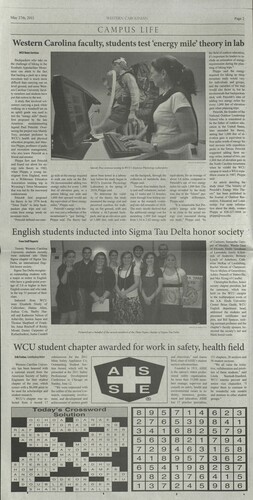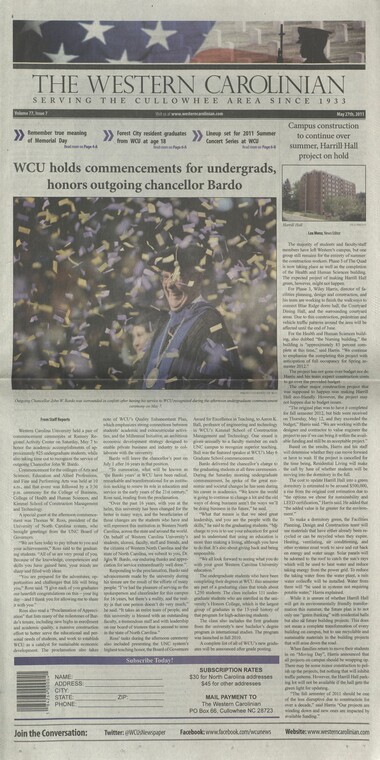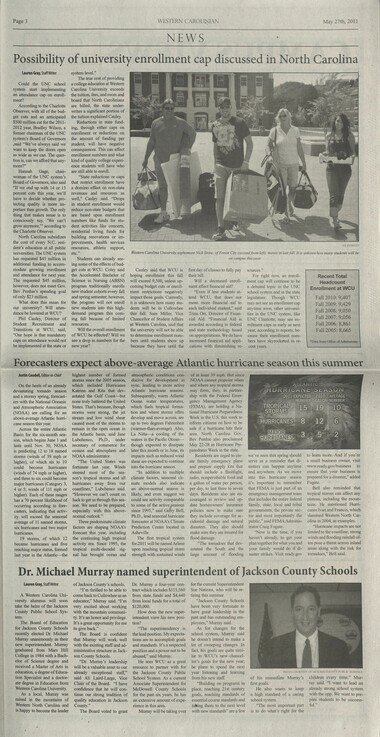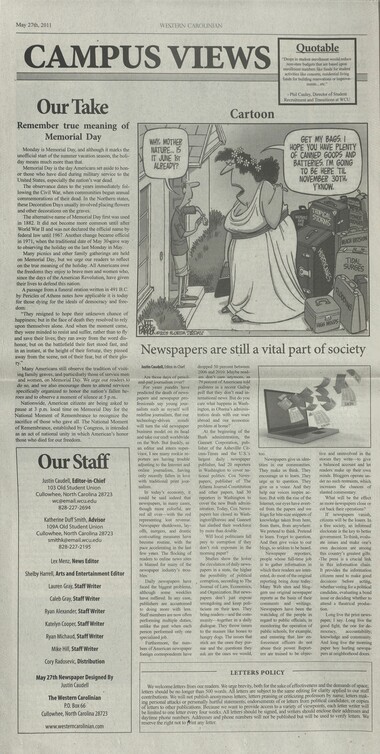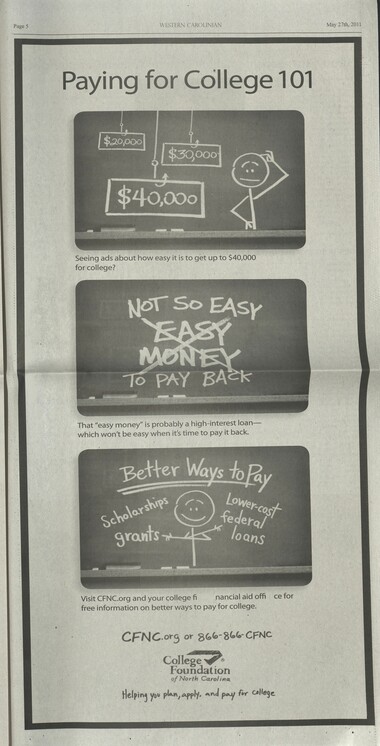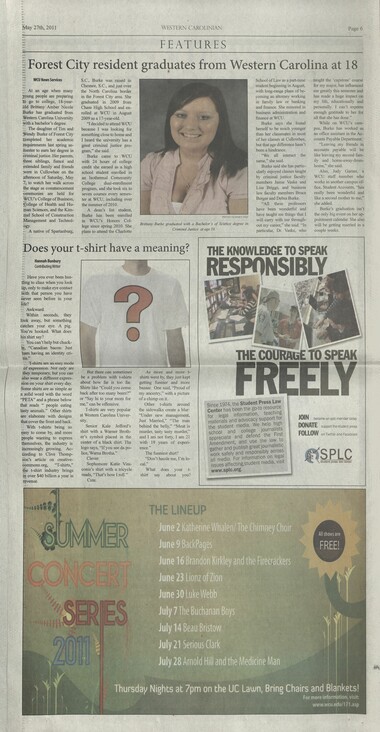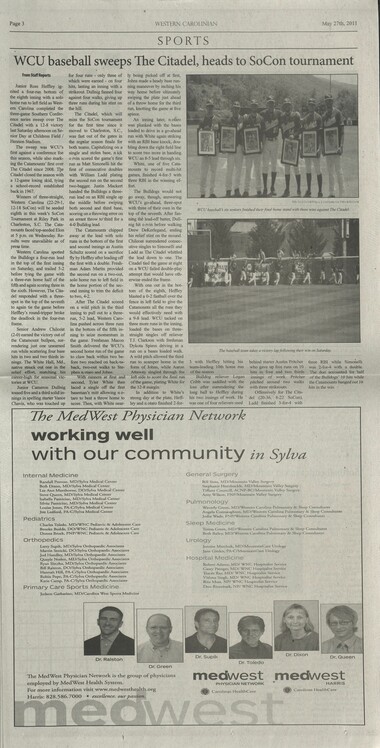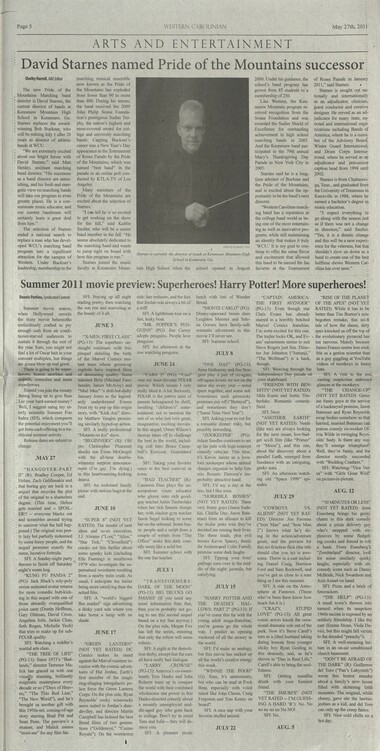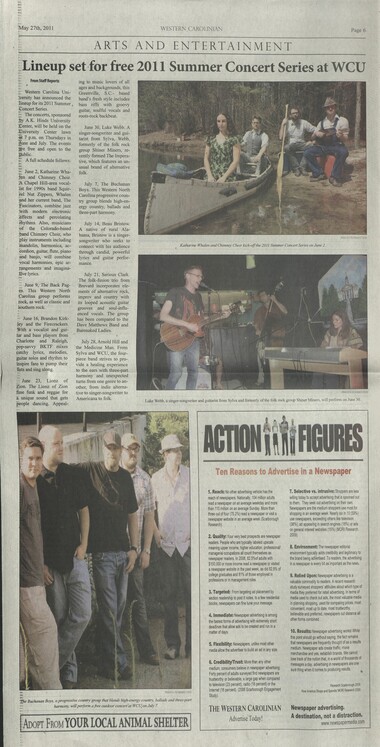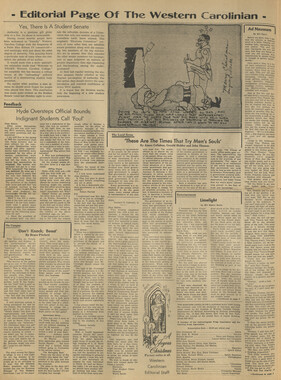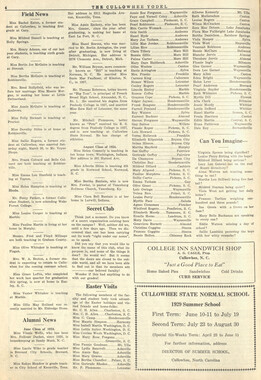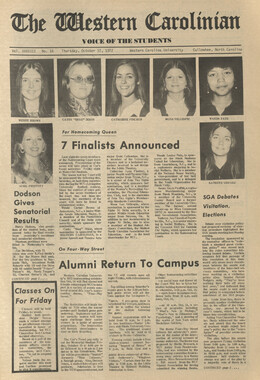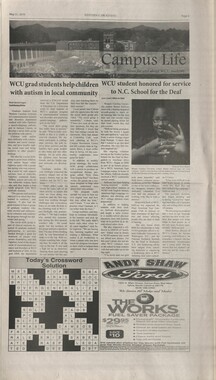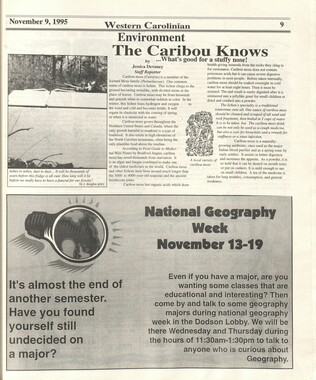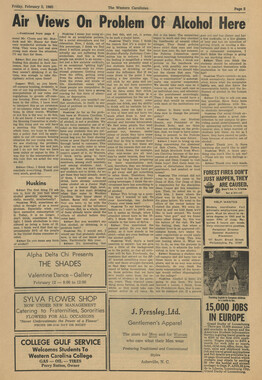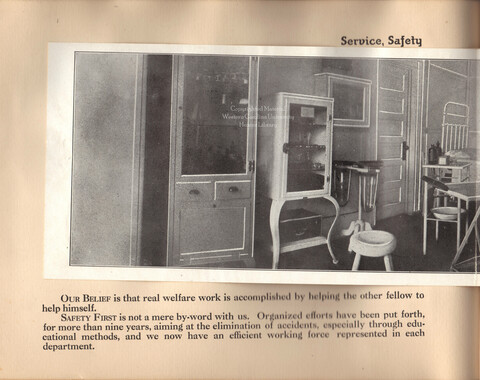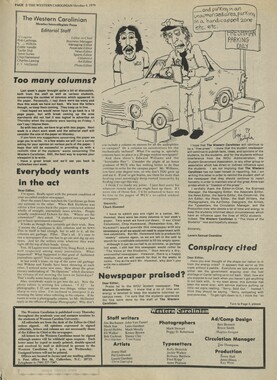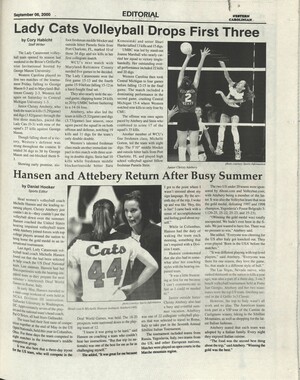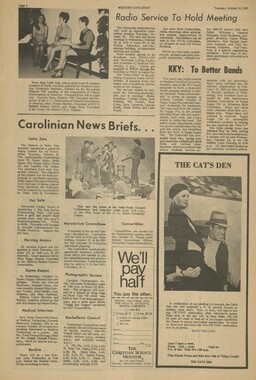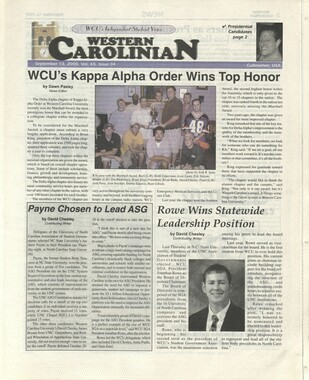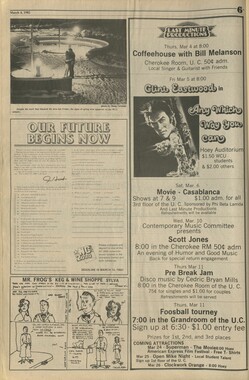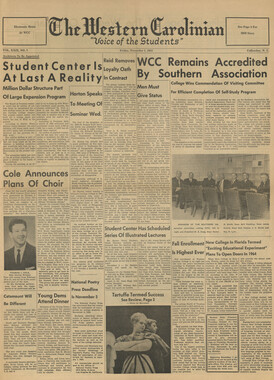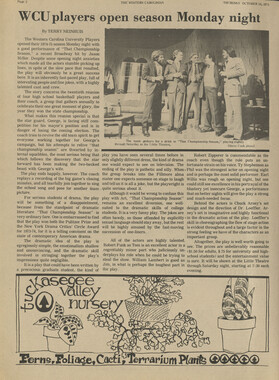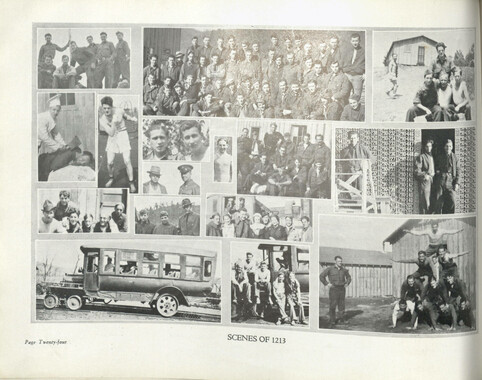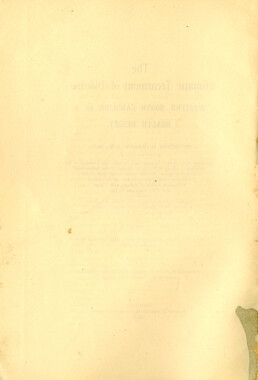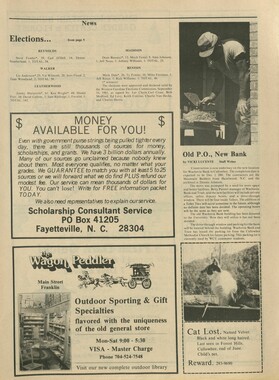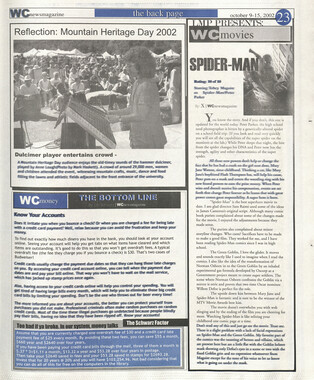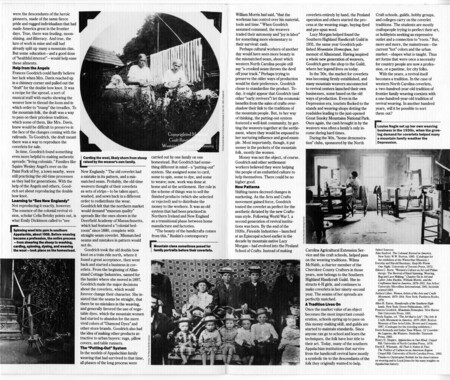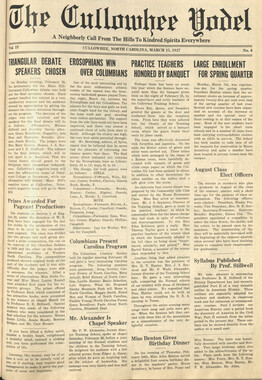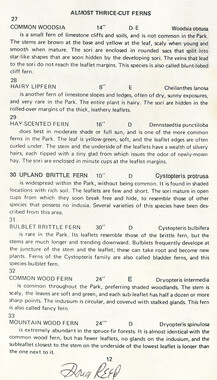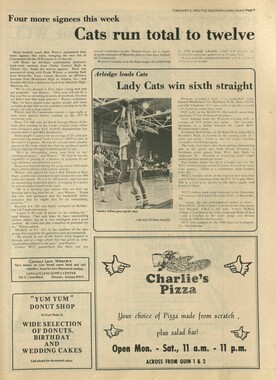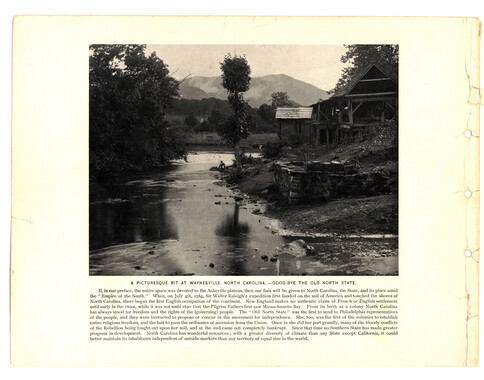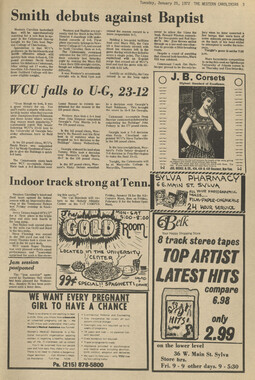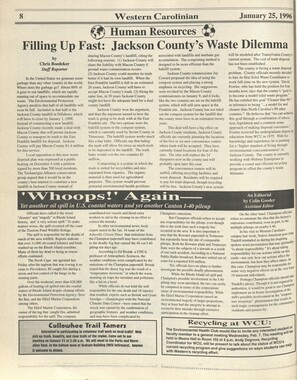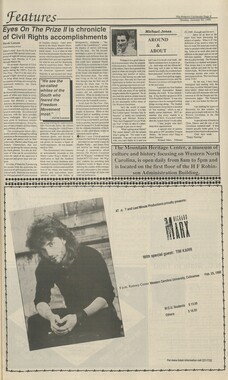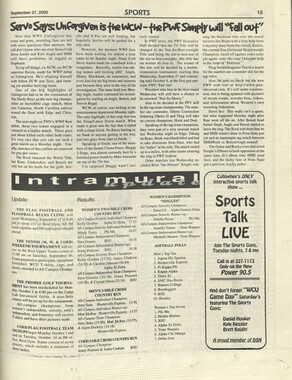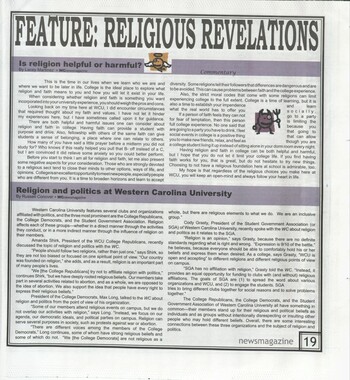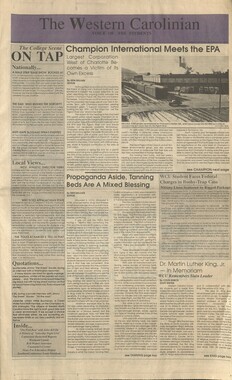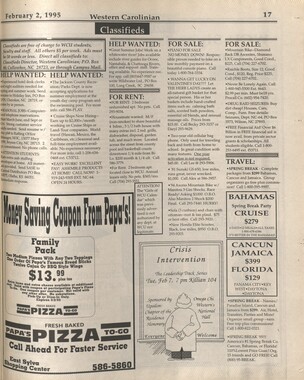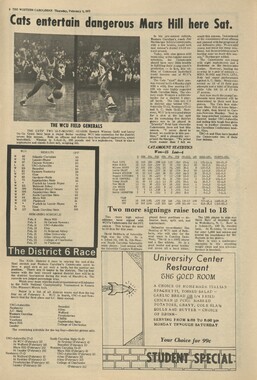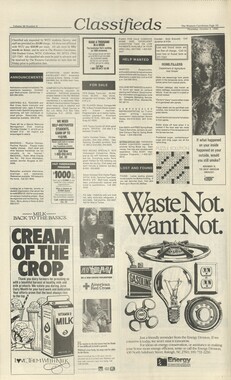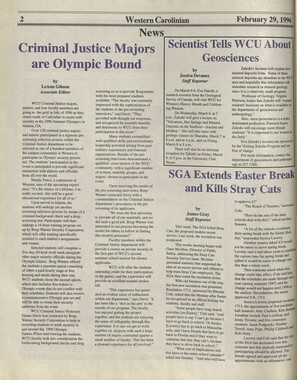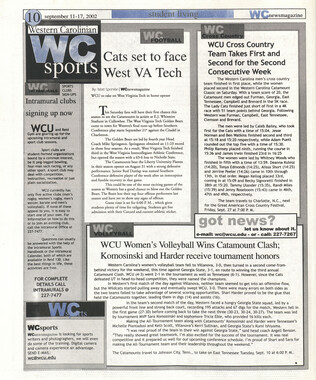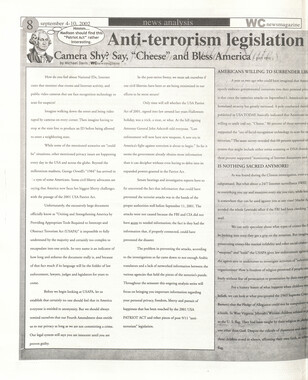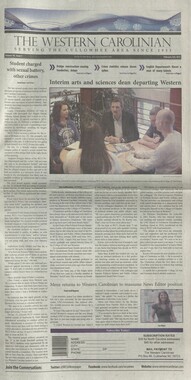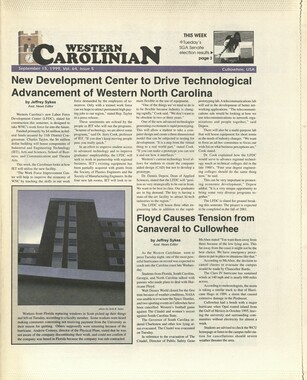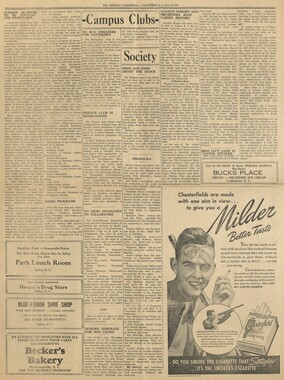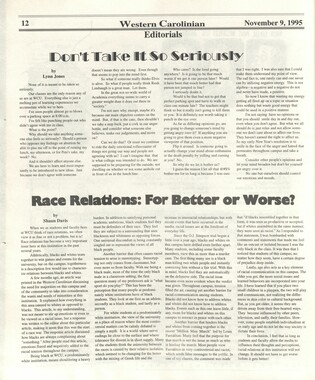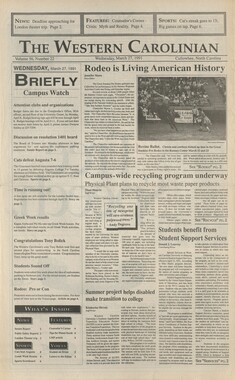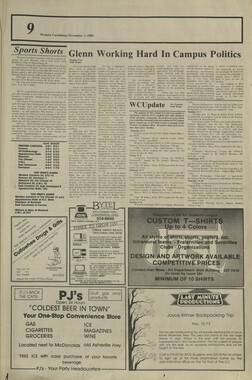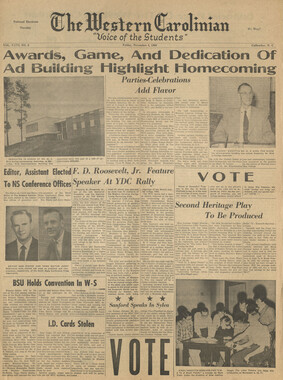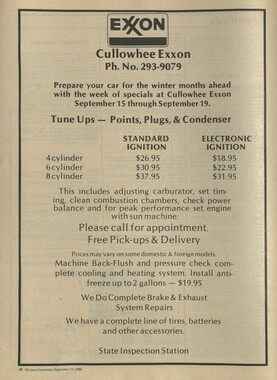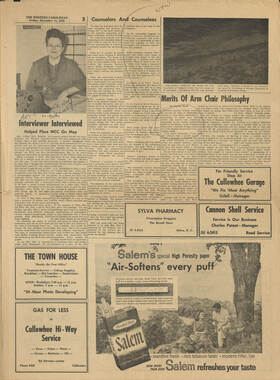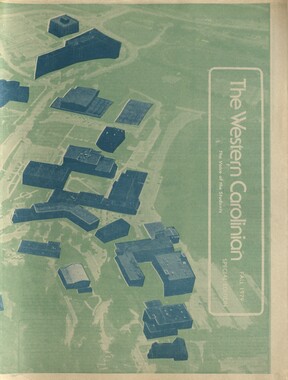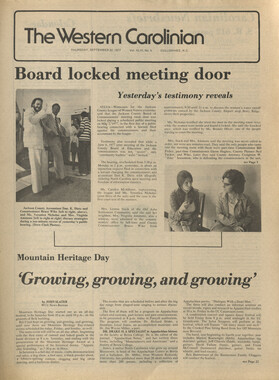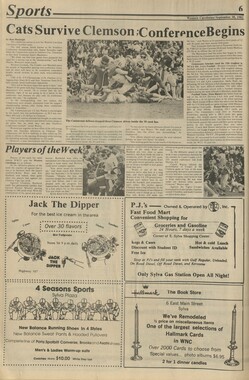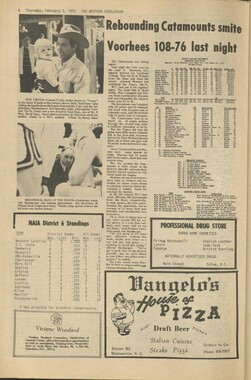Western Carolina University (21)
View all
- Canton Champion Fibre Company (2308)
- Cherokee Traditions (291)
- Civil War in Southern Appalachia (165)
- Craft Revival (1942)
- George Masa Collection (137)
- Great Smoky Mountains - A Park for America (2900)
- Highlights from Western Carolina University (422)
- Horace Kephart (973)
- Journeys Through Jackson (159)
- LGBTQIA+ Archive of Jackson County (85)
- Oral Histories of Western North Carolina (316)
- Picturing Appalachia (6797)
- Stories of Mountain Folk (413)
- Travel Western North Carolina (153)
- Western Carolina University Fine Art Museum Vitreograph Collection (129)
- Western Carolina University Herbarium (92)
- Western Carolina University: Making Memories (738)
- Western Carolina University Publications (2491)
- Western Carolina University Restricted Electronic Theses and Dissertations (146)
- Western North Carolina Regional Maps (71)
- World War II in Southern Appalachia (131)
University of North Carolina Asheville (6)
View all
- Allanstand Cottage Industries (62)
- Appalachian National Park Association (53)
- Bennett, Kelly, 1890-1974 (1463)
- Berry, Walter (76)
- Brasstown Carvers (40)
- Carver, George Washington, 1864?-1943 (26)
- Cathey, Joseph, 1803-1874 (1)
- Champion Fibre Company (233)
- Champion Paper and Fibre Company (297)
- Cherokee Indian Fair Association (16)
- Cherokee Language Program (22)
- Crowe, Amanda (40)
- Edmonston, Thomas Benton, 1842-1907 (7)
- Ensley, A. L. (Abraham Lincoln), 1865-1948 (275)
- Fromer, Irving Rhodes, 1913-1994 (70)
- George Butz (BFS 1907) (46)
- Goodrich, Frances Louisa (120)
- Grant, George Alexander, 1891-1964 (96)
- Heard, Marian Gladys (60)
- Kephart, Calvin, 1883-1969 (15)
- Kephart, Horace, 1862-1931 (313)
- Kephart, Laura, 1862-1954 (67)
- Laney, Gideon Thomas, 1889-1976 (439)
- Masa, George, 1881-1933 (61)
- McElhinney, William Julian, 1896-1953 (44)
- Niggli, Josephina, 1910-1983 (10)
- North Carolina Park Commission (105)
- Osborne, Kezia Stradley (9)
- Owens, Samuel Robert, 1918-1995 (11)
- Penland Weavers and Potters (36)
- Roberts, Vivienne (15)
- Roth, Albert, 1890-1974 (142)
- Schenck, Carl Alwin, 1868-1955 (1)
- Sherrill's Photography Studio (2565)
- Southern Highland Handicraft Guild (127)
- Southern Highlanders, Inc. (71)
- Stalcup, Jesse Bryson (46)
- Stearns, I. K. (213)
- Thompson, James Edward, 1880-1976 (226)
- United States. Indian Arts and Crafts Board (130)
- USFS (683)
- Vance, Zebulon Baird, 1830-1894 (1)
- Weaver, Zebulon, 1872-1948 (58)
- Western Carolina College (230)
- Western Carolina Teachers College (282)
- Western Carolina University (2008)
- Western Carolina University. Mountain Heritage Center (18)
- Whitman, Walt, 1819-1892 (10)
- Wilburn, Hiram Coleman, 1880-1967 (73)
- Williams, Isadora (3)
- Cain, Doreyl Ammons (0)
- Crittenden, Lorraine (0)
- Rhodes, Judy (0)
- Smith, Edward Clark (0)
- Appalachian Region, Southern (2940)
- Asheville (N.C.) (1944)
- Avery County (N.C.) (26)
- Blount County (Tenn.) (195)
- Buncombe County (N.C.) (1680)
- Cherokee County (N.C.) (283)
- Clay County (N.C.) (556)
- Graham County (N.C.) (238)
- Great Smoky Mountains National Park (N.C. and Tenn.) (525)
- Haywood County (N.C.) (3573)
- Henderson County (N.C.) (70)
- Jackson County (N.C.) (4919)
- Knox County (Tenn.) (35)
- Knoxville (Tenn.) (13)
- Lake Santeetlah (N.C.) (10)
- Macon County (N.C.) (421)
- Madison County (N.C.) (216)
- McDowell County (N.C.) (39)
- Mitchell County (N.C.) (135)
- Polk County (N.C.) (35)
- Qualla Boundary (982)
- Rutherford County (N.C.) (78)
- Swain County (N.C.) (2185)
- Transylvania County (N.C.) (270)
- Watauga County (N.C.) (12)
- Waynesville (N.C.) (86)
- Yancey County (N.C.) (72)
- Aerial Photographs (3)
- Aerial Views (60)
- Albums (books) (4)
- Articles (1)
- Artifacts (object Genre) (228)
- Bibliographies (1)
- Biography (general Genre) (2)
- Cards (information Artifacts) (38)
- Clippings (information Artifacts) (192)
- Copybooks (instructional Materials) (3)
- Crafts (art Genres) (622)
- Depictions (visual Works) (21)
- Design Drawings (1)
- Digital Moving Image Formats (2)
- Drawings (visual Works) (185)
- Envelopes (101)
- Exhibitions (events) (1)
- Facsimiles (reproductions) (1)
- Fiction (general Genre) (4)
- Financial Records (12)
- Fliers (printed Matter) (67)
- Glass Plate Negatives (381)
- Guidebooks (2)
- Internegatives (10)
- Interviews (817)
- Land Surveys (102)
- Letters (correspondence) (1045)
- Manuscripts (documents) (618)
- Maps (documents) (177)
- Memorandums (25)
- Minutes (administrative Records) (59)
- Negatives (photographs) (6090)
- Newsletters (1290)
- Newspapers (2)
- Notebooks (8)
- Occupation Currency (1)
- Paintings (visual Works) (1)
- Pen And Ink Drawings (1)
- Periodicals (193)
- Personal Narratives (10)
- Photographs (12976)
- Plans (maps) (1)
- Poetry (6)
- Portraits (4568)
- Postcards (329)
- Programs (documents) (181)
- Publications (documents) (2444)
- Questionnaires (65)
- Relief Prints (26)
- Sayings (literary Genre) (1)
- Scrapbooks (282)
- Sheet Music (2)
- Slides (photographs) (402)
- Songs (musical Compositions) (2)
- Sound Recordings (796)
- Specimens (92)
- Speeches (documents) (18)
- Tintypes (photographs) (8)
- Transcripts (324)
- Text Messages (0)
- A.L. Ensley Collection (275)
- Appalachian Industrial School Records (7)
- Appalachian National Park Association Records (336)
- Axley-Meroney Collection (2)
- Bayard Wootten Photograph Collection (20)
- Bethel Rural Community Organization Collection (7)
- Blumer Collection (5)
- C.W. Slagle Collection (20)
- Canton Area Historical Museum (2110)
- Carlos C. Campbell Collection (462)
- Cataloochee History Project (64)
- Cherokee Studies Collection (4)
- Daisy Dame Photograph Album (5)
- Daniel Boone VI Collection (1)
- Doris Ulmann Photograph Collection (112)
- Elizabeth H. Lasley Collection (1)
- Elizabeth Woolworth Szold Fleharty Collection (4)
- Frank Fry Collection (95)
- George Masa Collection (173)
- Gideon Laney Collection (452)
- Hazel Scarborough Collection (2)
- Hiram C. Wilburn Papers (28)
- Historic Photographs Collection (236)
- Horace Kephart Collection (861)
- Humbard Collection (33)
- Hunter and Weaver Families Collection (1)
- I. D. Blumenthal Collection (4)
- Isadora Williams Collection (4)
- Jesse Bryson Stalcup Collection (47)
- Jim Thompson Collection (224)
- John B. Battle Collection (7)
- John C. Campbell Folk School Records (80)
- John Parris Collection (6)
- Judaculla Rock project (2)
- Kelly Bennett Collection (1482)
- Love Family Papers (11)
- Major Wiley Parris Civil War Letters (3)
- Map Collection (12)
- McFee-Misemer Civil War Letters (34)
- Mountain Heritage Center Collection (4)
- Norburn - Robertson - Thomson Families Collection (44)
- Pauline Hood Collection (7)
- Pre-Guild Collection (2)
- Qualla Arts and Crafts Mutual Collection (12)
- R.A. Romanes Collection (681)
- Rosser H. Taylor Collection (1)
- Samuel Robert Owens Collection (94)
- Sara Madison Collection (144)
- Sherrill Studio Photo Collection (2558)
- Smoky Mountains Hiking Club Collection (616)
- Stories of Mountain Folk - Radio Programs (374)
- The Reporter, Western Carolina University (510)
- Venoy and Elizabeth Reed Collection (16)
- WCU Gender and Sexuality Oral History Project (32)
- WCU Mountain Heritage Center Oral Histories (25)
- WCU Oral History Collection - Mountain People, Mountain Lives (71)
- WCU Students Newspapers Collection (1923)
- Western North Carolina Tomorrow Black Oral History Project (69)
- William Williams Stringfield Collection (2)
- Zebulon Weaver Collection (109)
- African Americans (390)
- Appalachian Trail (35)
- Artisans (521)
- Cherokee art (84)
- Cherokee artists -- North Carolina (10)
- Cherokee language (21)
- Cherokee pottery (101)
- Cherokee women (208)
- Church buildings (190)
- Civilian Conservation Corps (U.S.) (111)
- College student newspapers and periodicals (2012)
- Dams (108)
- Dance (1023)
- Education (222)
- Floods (63)
- Folk music (1015)
- Forced removal, 1813-1903 (2)
- Forest conservation (220)
- Forests and forestry (1197)
- Gender nonconformity (4)
- Great Smoky Mountains National Park (N.C. and Tenn.) (181)
- Hunting (46)
- Landscape photography (25)
- Logging (119)
- Maps (83)
- Mines and mineral resources (9)
- North Carolina -- Maps (18)
- Paper industry (38)
- Postcards (255)
- Pottery (135)
- Railroad trains (72)
- Rural electrification -- North Carolina, Western (3)
- School integration -- Southern States (2)
- Segregation -- North Carolina, Western (5)
- Slavery (5)
- Sports (452)
- Storytelling (243)
- Waterfalls -- Great Smoky Mountains (N.C. and Tenn.) (66)
- Weaving -- Appalachian Region, Southern (280)
- Wood-carving -- Appalachian Region, Southern (328)
- World War, 1939-1945 (173)
Western Carolinian Volume 77 Number 07
Item
Item’s are ‘child’ level descriptions to ‘parent’ objects, (e.g. one page of a whole book).
-
-
May 27th, 2011 WESTERN CAROLINIAN Page 2_ CAMPUS LIFE Western Carolina faculty, students test eneIsy mile theory in lab Wwe News Services Backpackers who take on . the challenge of hiking in the Southern Appalachian Moun- tains can attest to the fact that hauling a pack up a steep mountain trail is much more difficult than carrying one on level ground, and some West- ern Carolina University facul- ty members and students have put that notion to the test. A study that involved vol- unteers carrying a pack while walking on a treadmill set on an uphill grade was.used to test the energy mile theory first proposed by the late. American mountaineering legend Paul Petzoldt. Over- seeing the project was Maridy Troy, assistant professor in WCUs health and physical education program, and Mau- rice Phipps, professor of parks and recreation management, who also knew Petzoldt as a friend and mentor. Phipps first, met Petzoldt, and found out about his en- ergy mile theory in 1982, when Phipps, a young im- migrant from England, went on a Wilderness Education Association training trip in Wyomings Teton Mountains _ that was led by the renowned outdoorsman. Petzoldt first proposed his theory in his 1976 book - Teton Trails to help back- ' packers plan trips and cal- culate their energy needs on mountain trails. Petzoldt defined one ener- gy mile as the energy required to walk one mile on the flat. He recommended adding two energy miles for every 1,000 feet of elevation gain, so a person hiking one mile and 1,000 feet upward would use the equivalent of three energy miles, Phipps said. Petzoldts energy mile the- ory was just a reflection of the mountaineers gut feeling, Phipps said. The theory had never been tested in a labora- tory before the study began in WCUs Exercise Physiology Laboratory in the spring of 2010, Phipps said. To determine the valid-. ity of the theory, the study measured, the energy cost and perceived exertion for walk-. ing on flat ground, with and without a 44.5-pound back- pack, and up an elevation gain of 1,000 feet, with and with- out the backpack, through the collection of metabolic data, Phipps said. Twenty-four student, facul- ty and staff volunteers, includ- ing 12 males and 12 females, went through four testing ses- - sions as the research contin- ued into fall semester of 2010. The study results showed that the additional energy cost for ascending 1,000 feet ranged from 1.34 to 2.02 energy mile equivalents, for an average of about t.6 miles, compared to Petzoldts use of two energy miles for each 1,000 feet. The range revealed by the study was due to the hikers per- sonal weight differences, Phipps said. _ Tt is remarkable that Pet- zoldts energy mile theory is so close to the actual en- ergy cost measured during our study, Phipps said. In ' the field of outdoor education, its important for leaders to in- clude an estimation of energy requirements during the plan- ning of hiking trips. Phipps said the energy - required for hiking up steep * mountain trails would vary for individuals and groups, . and the variables of the trail < would also factor in, but he. recommends that backpackers | stick with Petzoldts idea of adding two energy miles for : every 1,000 feet of elevation gain when planning trips. Petzoldt, the founder of the + National Outdoor Leadership School who is considered to : be the father of outdoor edu- . cation in the United States, . later amended his. theory, stating that 1,000 feet of el- . evation gain is equivalent to four miles worth of energy for trail novices with expedition + packs in the Tetons. Petzoldt suggested adding three en-~ ergy miles, instead of two, per 1,000 feet of elevation gain in the North Carolina mountains . when he visitd the WCU campus to teach a WEA expe- ; dition course in 1987, ue said. * An article detailing ihe ta study titled The Validity of Petzoldts Energy Mile The- ~ ory has been published in: the Journal of Outdoor Rec-.: reation, Education and Lead-... ership. For more informa- . tion about the study, contact: Phipps at 828-227-3844 or: phipps@wceu.edu. English students inducted into Sigma Tau Delta honor society - - From Staff Reports i Twenty Western Carolina University students recently were inducted into Theta Sigma chapter of Sigma Tau Delta, an international Eng- lish honor society. Sigma Tau Delta recogniz- es outstanding students with a major or mihor in English _ who have a grade-point aver- age of 3.0 or higher in their English courses and who rank in the top 35 percent of their class. Inducted from WCU were Elizabeth Nissly of Cullowhee; Hanna Allen, Joshua Cole, Shelby Har- rell and Katherine Nelson of Asheville; Jessica Jaqua and Thomas Shepherd of Frank- lin; Anna Bischoff of Rocky Mount; Dasiey Carpenter of Rutherfordton; Justin Caudell PHOTO SUBMITTED Pictured are a handful of the newest members of the Theta Sigma chapter of Sigma Tau Delta. of Cashiers; Samantha Gam- -pel of Murphy; Wanda Gant of Etowah; Emily Goodman >| of Lawndale; Emily Kilpat-. rick of Andrews; Brittany - Lynch of Asheboro; Cath- erine McRae of Laurinburg; .. Rachel Moore of Claremont; :: Travis Mullen of Greensboro; Ashley Pennell of Statesville; and Mai Xiong of Candler. Christopher Rollins, honor society chapter president, led the ceremony, which was held on the WCU campus in the multipurpose room of : the A.K. Hinds University Center. Brian Gastle, WCU English department head, addressed the students and presented certificates and pins, and Bill Spencer, visit- ing assistant professor and the chapters faculty sponsor, be- stowed the societys red and black honor cords. WCU student chapter awarded for work} in safety, health field Erik Freitas, Contributing Writer Western Carolina Univer- : sity has been honored with a national award from. the American Society of Safety Engineers for best student chapter of the year, which comes with a $6,000 prize to be used for scholarships and student research. WCUs chapter was se- lected from a record 17 submissions for the 2011 Mine Safety Appliance Co. Outstanding Student Sec- tion Award, which will be presented at the 2011 Safety Professional | Development Conference in Chicago on Sunday, June 12. We were impressed with the caliber of the sections re- search, community involve- ment, and development and achievement of section goals Pie > zp ie GuaGae oO F e = T Wale Kea | O| Ss R ar A ae R a 2} [anf +[m]o] s/o] | SREBOES Sc = m]o|=[o]s]o]o]a|~ | fo}a]o]r]o|o|= aoa] )}o|=}ujols 0] 8) [2]=|NJa]olo, 2|=[0/o]0/o]n] 5/0 o}a|sr}o|sfo]=|o and objectives, said Aaron Bird, chair of ASSEs student section subcommittee. Founded in 1911, ASSE is the nations oldest profes- sional safety organization. Its more than 33,000 mem- bers manage, supervise and consult on safety, health and environmental issues in. in- dustry, insurance, govern- ment and education. ASSE has 17 practice specialties, 151 chapters, 28 sections and 58 student sections. We all value the initia- tive, collaboration and priori- ties of these students, said Linda Seestedt-Stanford, WCU interim provost and senior vice chancellor. I expect them to continue to be wonderful role models and mentors to other student groups. a 4 ;
Object
Object’s are ‘parent’ level descriptions to ‘children’ items, (e.g. a book with pages).
-
The Western Carolinian is Western Carolina University's student-run newspaper. The paper was published as the Cullowhee Yodel from 1924 to 1931 before changing its name to The Western Carolinian in 1933.
-

